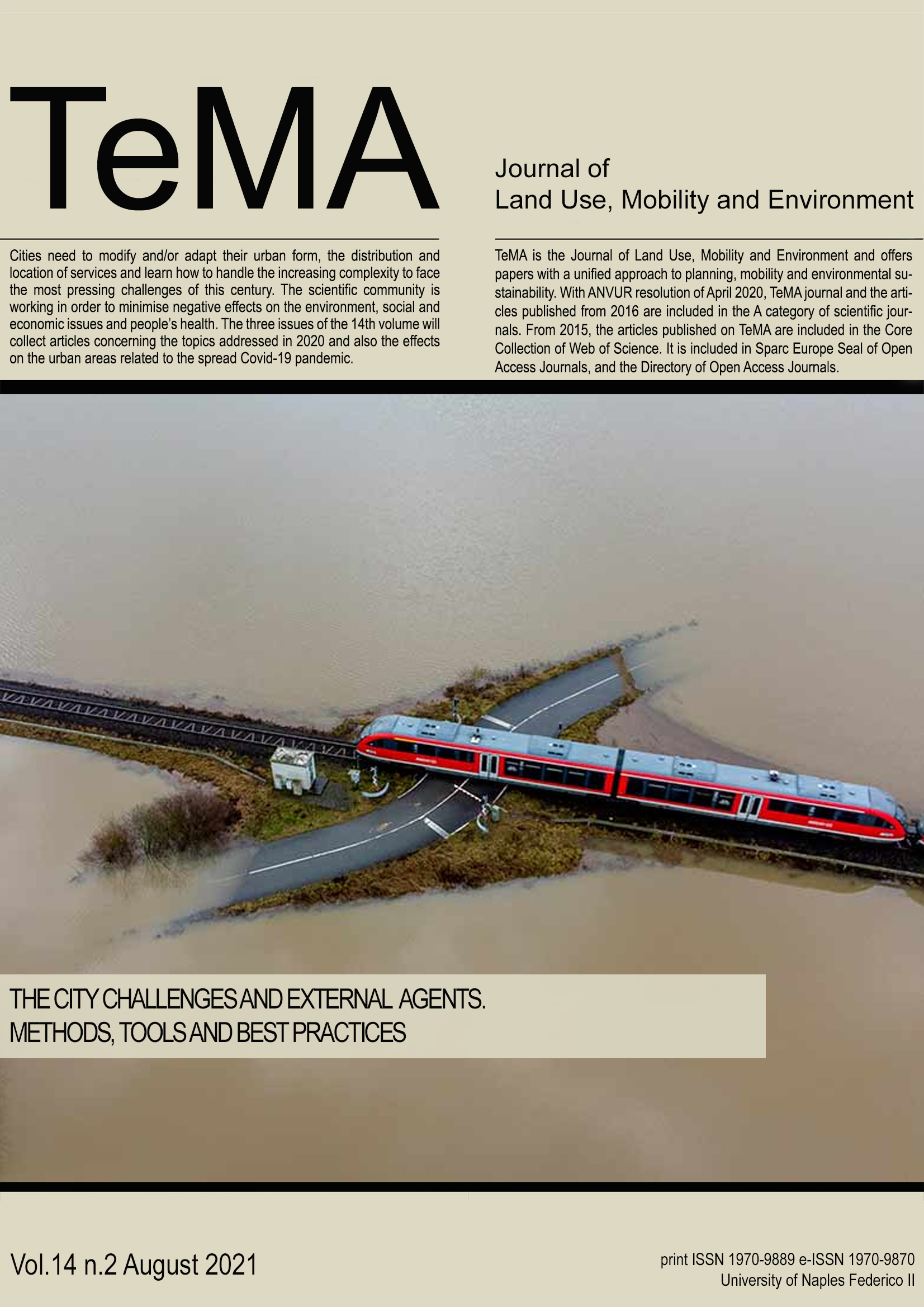Territorial disparities in Tuscan industrial assets: a model to assess agglomeration and exposure patterns
Abstract
Industrial agglomerates are considered drivers of urban development. This reiterative process of industrial growth, nevertheless, tends to increase regional territorial disparities, an asymmetrical development pattern that can lead to productive spaces’ underuse or abandonment. Although numerous economics studies about industrial distribution and territorial disparities were so far conceived, those are based on dated spatial methodologies. These consider space as an abstract background, hence, leaving unexplored several spatial relations between production, infrastructural networks and industrial agglomerates organization. Novel models ought to consider real attributes of space, being crucial to economic recovery in times of territorial constrains; with this in consideration, the paper objective is to construct and discuss a spatial-economic model tailored to assess territorial disparities in industrial agglomerates distribution and the condition here defined as territorial exposure. Exposure, represented by a composite spatial index, denotes disparities in territorial endowments, identified as factors of sensitivity or support to firms placed within industrial agglomerates, spatial conditions that can affect their capabilities to react to periods of economic recession and their post-crisis recovery. The model analyses Tuscany Region’s industrial structure and depicts territorial disparities in a GIS-based environment. The spatial knowledge produced can aid regional initiatives for economic recovery directed to Tuscan industries.
Downloads
References
Alonso W. (1964). Location and Land Use. Harvard University Press. https://doi.org/10.4159/harvard.9780674730854
Altafini D., Braga A., Cutini V. (2021). Planning sustainable urban-industrial configurations: relations among industrial complexes and the centralities of a regional continuum. In: International Planning Studies, 1-21. https://doi.org/10.1080/13563475.2021.1875810
Altafini D., Cutini V., (2020). Tuscany configurational atlas: a GIS-based multiscale assessment of road-circulation networks centralities hierarchies. In: Gervasi O et al. (a cura di) Computational Science and its Applications, Lecture notes in Computer Science. Cham: Springer Nature, 291-306.
Bellandi M., Lombardi S., Santini E., (2019). Traditional manufacturing areas and the emergence of product-service systems: the case of Italy. J. Ind. Bus. Econ. 47, 311–331. https://doi.org/10.1007/s40812-019-00140-y
Capello R., (2015) Regional Economics. Routledge.
Campagna M. (2020). Geographic Information and Covid-19 Outbreak Does the spatial dimension matter?. TeMA - Journal of Land Use, Mobility and Environment, 31-44. https://doi.org/10.6092/1970-9870/6850
Cheshire P; Mills E.S. (eds.) (1999) Handbook of Regional and Urban Economics. Applied Urban Economics. 3. Amsterdam. Elsevier – North-Holland
Di Ludovico D., Di Lodovico, L., & Basi, M. (2021). Spatial knowledge for risks prevention and mitigation. TeMA - Journal of Land Use, Mobility and Environment, 39-51. https://doi.org/10.6093/1970-9870/7404
Duranton G., Henderson J.V., Strange W. (eds.) (2015a). Handbook of Regional and Urban Economics: Regional and Urban Economics. Vol. 5A. Amsterdam. Elsevier – North-Holland
Duranton G., Henderson J.V., Strange W. (eds.) (2015b). Handbook of Regional and Urban Economics: Regional and Urban Economics. Vol. 5b. Amsterdam. Elsevier – North-Holland
Fracasso A., Vittucci Marzetti G., (2018). Estimating dynamic localization economies: the inadvertent success of the specialization index and the location quotient. Reg Stud. 52, 119–132 https://doi.org/10.1080/00343404.2017.1281388
Francini M., Margiotta N., Palermo A., & Viapiana M. F. (2020). A GIS-based automated procedure to assess disused areas. TeMA - Journal of Land Use, Mobility and Environment, 13 (3), 309-328. https://doi.org/10.6092/1970-9870/7039
Henderson J. V., Thisse J.F. (eds.) (2004). Handbook of Regional and Urban Economics: Cities and Geography. Vol. 4. Amsterdam. Elsevier – North-Holland
Hillier B., Yang T., Turner A. (2012). Normalising least angle choice in Depthmap - and how it opens up new perspectives on the global and local analysis of city space, The Journal of Space Syntax, 3(2), 155–193.
Lefèbrve H. (1996). Writings on Cities. Blackwell, Oxford.
Lefèbrve H. (1974). La production de l’espace. Éditions Anthropos, Paris.
Mills E.S. (ed.) (1987). Handbook of Regional and Urban Economics: Urban Economics. Vol 2. Amsterdam. Elsevier – North-Holland
Nijkamp P. (ed.) (1986). Handbook of Regional and Urban Economics: Regional Economics. Vol 1. Amsterdam. Elsevier – North-Holland
Regione Toscana (2019a). Direzione Urbanistica e Politiche Abitative - Sistema Informativo Territoriale e Ambientale – SITA.: Edificato 2k, 10k 1988-2013. http://www502.regione.toscana.it/geoscopio/cartoteca.html
Regione Toscana (2019b) Direzione Urbanistica e Politiche Abitative - Sistema Informativo Territoriale e Ambientale – SITA.: Grafo stradario e ferroviario della Regione Toscana - Itnet. http://www502.regione.toscana.it/geoscopio/cartoteca.html
QGIS (2020). Hannover. Version 3.16.3.
Smith N. (2008). Uneven Development: Nature Capital and the Production of Space, 3rd ed. The University of Georgia Press, Georgia.
Turner A. (2001). Angular Analysis. In: Proceedings of the 3rd International Symposium on Space Syntax, pages 7-11. Georgia Institute of Technology, Atlanta, Georgia.
Weber A., (1929). Theory of the Location of Industries. The University of Chicago Press, Chicago. https://doi.org/10.1086/254099
Copyright (c) 2021 TeMA - Journal of Land Use, Mobility and Environment

This work is licensed under a Creative Commons Attribution 4.0 International License.
Authors who publish in this journal agree to the following:
1. Authors retain the rights to their work and give in to the journal the right of first publication of the work simultaneously licensed under a Creative Commons License - Attribution that allows others to share the work indicating the authorship and the initial publication in this journal.
2. Authors can adhere to other agreements of non-exclusive license for the distribution of the published version of the work (ex. To deposit it in an institutional repository or to publish it in a monography), provided to indicate that the document was first published in this journal.
3. Authors can distribute their work online (ex. In institutional repositories or in their website) prior to and during the submission process, as it can lead to productive exchanges and it can increase the quotations of the published work (See The Effect of Open Access)

